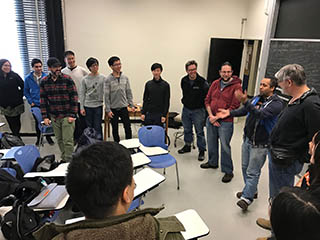Summary
The goal of this first activity is to communicate the structure of the class, set the tone and expectations, and to get students comfortable enough to form groups of 4–6 students and to have them begin working through a guided online tutorial with a lot of discussion about questions that arise. On this page, we describe our approach to kicking off a successful class.
Course Overview

Members introduce themselves and play an improv game. (Image by H. Sharon Lin, MIT OpenCourseWare.)
We begin the classes by introducing the teaching staff and giving some background about what brought us to teach this course. We also cover the timeline of the course and discuss the type of projects the students will be working on during the project phases (having videos on hand for demonstrating the project expectations is very helpful). This introduction is an important time in which you as an instructor can model the type of vulnerability and engagement that you expect from the participants. This is also the time to set expectations about student conduct and behavior. For this class, I explicitly state that we will be using online tutorials and that the whole point of being in a classroom together is to engage in social learning through collaboration and support. This is a good time to cover any other logistic stuff such as video release forms.
Introductions
The goal of this first activity is to get students comfortable enough to form a group of 4–6 students and have them begin working through a tutorial as a group. Since this is the first time the students are meeting, and the class is built around group projects, it is important to give the students some fodder for connection. The first way to facilitate this is through the usual activity of asking each student to tell the whole group a few factoids about themselves, such as what the study in school, why they came to the class, if they have any previous experience with the technologies, and what their favorite one-handed food is. During this type of introduction, it is helpful to give a list of items for each student to speak to, this helps shy students have structure for introducing themselves and helps gregarious students stay within a reasonable time.

|
Getting Started: Q&AMark Vrablic and Kyle Keane answer questions from students about the class, activities, and technology being used. |

|
Getting Started: Introducing IntroductionsKyle Keane describes the first ice breaker of the class and how we will manage the task of having everyone introduce themselves. |

|
Getting Started: IcebreakerKyle Keane describes a basic icebreaker for the class to introduce themselves to each other by providing information about things like where they are from, their favorite food, and what they hope to do in the class. |










